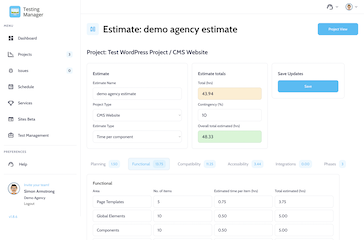
The third post in our blog series covering each aspect of auditing a typical website. We're tackling usability and how to uncover issues surrounding how people actually use your website.
In the last post we were breaking down browser compatibility and our first post in the series focused on functionality.
An unusable website or one with poor usability is not much good to anyone, especially you as the site owner or manager. In fact, issues with the usability of your website can mean that users don't buy from you, don't come back to your site or recommend you to others. Problems with your website's usability can even have a negative impact on the perception of your organisation as a whole, extending further than just the website.
So how do you go about assessing the usability of your website to make sure it is not turning potential customers away? Here are some suggestions:
Put yourself in their shoes, enter the website with the mindset of wanting to find out about your company or view information on a particular product, find out how much it is, what the shipping costs are, how to return the product if it is not what you wanted, etc.
Ask yourself simple questions whilst you review the website, you can break them down into different areas such as:
There are many more items that you could check for each usability audit but the above sections and example questions you could ask yourself whilst reviewing the website should give you a good start.
A good way of getting some instant feedback is to sit down with a colleague, friend or family member, preferable somebody who hasn't seen your website before, and ask them to use the website whilst you watch what they do.
Whilst making notes on areas that your usability tester finds difficult, you can ask them certain questions on their experience of the site or set certain tasks such as finding specific product information, submit an enquiry, find out what our fax number is or download one of our white papers.
You will certainly find out first hand what barriers exist and areas that can be improved.
User testing is a relatively inexpensive way of picking up on usability issues by having a number of people, armed with webcams and microphones, try to use your website and carry out certain tasks that you set for them.
Services such as WhatUsersDo, UserTesting.com and OpenHallway enable you to set your tasks, select how many users (in the case of OpenHallway you have to supply your own users) and sit back whilst the users carry out the tasks whilst recording their thoughts and findings as they do so.
The users may not be your specific target market and it will depend on what tasks or questions you set for them to perform as to the results you get. Some analysis is required in order to establish the next steps or improvements that are required but user testing can be a great and comparatively cheap way to obtain solid feedback from real users reviewing your website.
There are many other usability testing tool that can give you an idea of how people are using your website and the kind of difficulties that they come across. Over on our Testing Web Sites blog, we have a directory of over 60 usability testing tools including heat-mapping, click-tracking, eye-tracking, online surveys and web analytics tools that can help you identify or find out about usability issues.
If you are really not sure what you should be looking for when reviewing your website's usability then there are several good books available that will help you understand the main principles.
The main book, which is a must read and helps make usability seem very straightforward is Steve Krug's 'Don't Make Me Think - A Common Sense Approach to Web Usability'. His more recent book is called 'Rocket Surgery Made Easy - The Do-It-Yourself Guide to Finding and Fixing Usability Problems' written in a similar straightforward and easy to understand style.
As the Internet matures, there has emerged a series of conventions that accumulate to form usability best practice for a variety of website scenarios. An organisation such as Econsultancy is a good place to start in order to find best practice on implementing a shopping basket and checkout system or product pages or mobile sites.
These best practice guides contain lots of information but there are many usability conventions to keep in mind such as:
Hopefully this blog post has given you some guidance on performing an audit of your website's usability. Assessing usability, improving usability issues and measuring the results is an ongoing process and therefore a usability audit is something that should be carried out regularly.
Your feedback is greatly appreciated on this blog post, let me know what you think about auditing the usability of your website in the comments.


